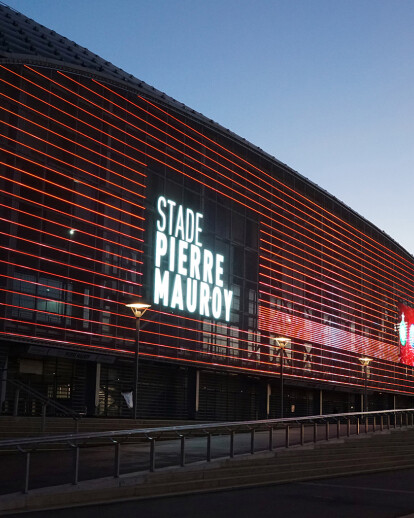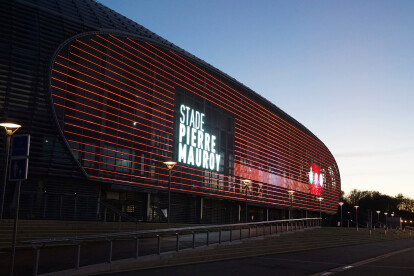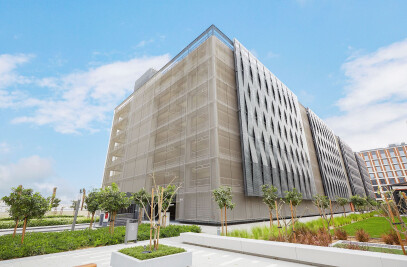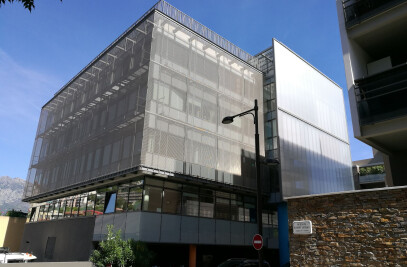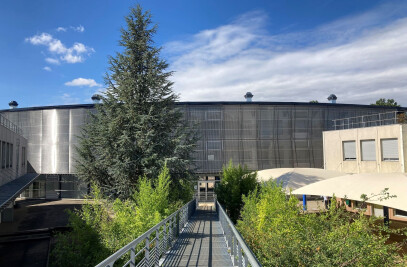The Grand Stade de Lille Métropole represents the joint work of two French architecture agencies:
VALODE et PISTRE Architectes and the Atelier FERRET Architectures. This project was constructed following a PPP competition won in 2008, for which the EIFFAGE group was the builder.
UNIQUE PORTRAIT OF AN AVANT-GARDIST STADIUM:
URBAN DEVELOPMENT - DESIGN - MULTI-PURPOSE
The architecture of the Grande Stade de Lille is governed by a multitude of concerns:
• urban (the stadium represents the seed of a new district of the City of Lille)
• objectives (more than a multi-sports stadium, it is a totally multi-purpose venue)
• spatial (the stadium is compact and convivial despite its capacity of over 50,000 seats)
• aesthetic (its design symbolises the innovation that characterises it, and makes it an emblem of Lille's urban community)
• constructive (its mobile structures - roofing, pitches and the design of its external structure represent real technological challenges)
AN URBAN STADIUM
The Grand Stade project is in line with the architectural and urban policy which the City of Lille has upheld for several years and which has enabled the creation of new districts boasting high quality such as Euralille. The Stadium is situated in the district of Borne de l'Espoir, a territory straddling the communes of Villeneuve d'Ascq and Lezennes, approximately ten kilometres from the centre of Lille.
The north facade has been devised like the facade of a building facing the street
The first challenge - the new stadium is situated on a site that is currently being developed. It was to be the essential element of this development and needed to be able to impress on a city-scale.
The plot is triangular in form. It is bordered by the boulevard de Tournai to the north and the boulevard du Breucq to the east. The first stage of our work consisted of laying out the stadium to the north-west of this triangle. A large space is cleared on the other three sides of the structure. The objective of this annular area is that it will become the centre of the new district which is developing around the stadium. An urban facade, flat and aligned on the boulevard de Tournai, cuts the ovoid form of the building. The facade and its concourse hold real significance on this boulevard, a distinct entrance overseeing orientation of the spectator and serving to affirm the stadium's multi-purpose vocation.
At night it becomes an illuminated interactive screen, a showcase of the stadium over the town.
A stadium without barriers - The stadium enclosure and access control perpendicular to the facade
A stadium is generally surrounded by a sealed enclosure, enabling access control. Most stadiums are designed within a closed perimeter which blocks off access during and outside of matches. We have therefore devised a stadium with an enclosure incorporated into its facade. During or outside of matches, with or without ticket, you can walk around this building. Its aim is to create dreams and emotions; in fact, you can glimpse the pitch behind its external structure, through the access points to the terraces of the lower section. In this way, the space fulfils its role as a permanent urban venue.
A refined urban, discreet presence
The gigantic size of a facility like a stadium lends itself very easily to monumental character (the stadium pitch alone covers 1 hectare). The integration of the stadium to lie at the heart of a future urban fabric required work on the scale of the building. We therefore embedded the first section of the terraces into the ground. The height of the building was thus reduced to 38 m. The underground area of level 0 (pitch level), which unites all the areas not accessible to the public (changing rooms, storage areas, internal service routes, technical and security premises, media rooms...) frees the ground level which becomes an immense annular ambulatory, an area of transition, visually open both to the public area and the pitch.
AN ELEGANT AND EMBLEMATIC DESIGN
Form - arena
The design of the arena represents the architectural response to a series of essential objectives:
- optimal visibility for all spectators
- maximum proximity of the entertainment for everyone
- great atmosphere within the stadium
- effective functionality in absolute safety
The compactness of the building, resulting essentially from work to optimise the curves of visibility, ensures that the spectator is always less than 140 m from the furthest point of the field (regulations authorise 190 m).
The arena is ovoid. It is composed of a lower general public section accessible from the level of the stadium concourse, a VIP and business balcony with lounges and attached boxes accessible from the ambulatory on level 1 and a top general public section accessible from the ambulatory on level 2.
The rounded, continuous, compact and enclosing form which surrounds the ground generates a great deal of atmosphere and conviviality in the stadium.
External structure - facade
Sporting enclosures are very popular public facilities with a media buzz and, as such, they become the emblems of cities. The Grand Stade de Lillewill also be a place with a cultural vocation. We have therefore developed an understandable and memorable form symbolic of spectators coming together for an event. It is a vast ovoid envelope, the transparent skin of which interacts with both daylight and with artificial light.
This curvilinear profile involved complex technical and geometrical operations. It operates like a filter which the eye can more or less penetrate. It is made from 32 km of hollow extruded polycarbonate tubes. They are 21 cm in diameter and are assembled by powder coated moulded aluminium parts. The spacing of the 21 cm tubes in the bottom part slowly and gradually increases as the facade gets higher. This system offers a facade that moves constantly according to the angle of view. Its tonality changes throughout the day and according to the seasons. During the day, the translucidity and the reflection of the polycarbonate tubes oversees harmonisation of the building and the sky and environment and transform it into a huge polished pebble. At night, its presence is revealed by the diffraction of the light in the tubes; during this time, the stadium looks like a great magic lantern.
Structure of the envelope
The envelope of the stadium relies on a succession of tall thin steel arches which regulate the movement of the spectators in the large ambulatory. The colours of these structures (different shades of grey) highlight the envelope tubes. The only exception being the "mega letters" of the signage, which feature the selected colour code (colour wheel) for the whole building. Apart from the signage, the only striking colour in the stadium is that of the pitch.
A MULTI-PURPOSE STADIUM
In order to make its operation profitable, nowadays, a stadium must be used not just for 25 annual football matches, but for other sports competitions or large-scale entertainment. It is not enough to install a stage for concerts or a Davis Cup tennis court on a stadium's pitch, as the spectator is too far from the action. A new architectural model had to be invented to provide genuine, high-quality multifunctionality.
The challenge was to design a spatial area in which the spectator feels just as happy watching a game of football, or basketball, a concert, an opera by Bizet, or even a piece choreographed by Angelin Preljocaj.
So the project sets itself three ambitious goals, which genuinely incorporate a high degree of technical and economic elements:
1 - to cover the entire arena, both terraces and pitch.
2 - to protect the pitch
3 - to provide the immediate proximity of the public to the entertainment in all configurations
Precursor - A stadium which sets a precedent
Even in terms of fire safety, this project involved rethinking and adapting the current regulations which did not take into consideration the possibility of creating a building that is both a stadium and an auditorium. This reflection led to a new regulation, governing Large Multi-Use Buildings. The Grand Stade de Lille Métropole has set a precedent.
The retractable roof
The highly technical retractable roof is an essential element of the design of the building. It opens lengthways in two halves. Each half consists of two "stacked roofs" which are stored one on top of the other in the open position. They complete the silhouette of the building and so contribute to the emblematic appearance of the stadium. The four parts of the retractable roof slide over two spindle-shaped gigantic beams, overhanging the longer sides of the pitch. These highly-stylised and distinctive powerful steel beams are a tribute to the steel-making heritage of the region. This stacking device is a world first, as up until now, existing retractable covers were designed in two halves, each consisting of a single roof. So, in the open position, the roof of the stadium remains in harmony with the volume of the whole. The totally smooth covering of the white PVC retractable roof offers a sleek envelope. The composition of the roof has been designed to be acoustically highly effective . So the average reverberation time achieved (between 2 and 3 seconds), despite the size of the building, makes it possible to organise high-quality entertainment.
A major architectural innovation - "The entertainment box"
The invention of the entertainment box represents the architectural response to two objectives:
1 - to protect the pitch, but without removing it completely onto the concourse as is the case with other stadiums
2 - to place the spectator as close as possible to the action in all configurations
Sliding the entire pitch outside the stadium would have resulted in the elimination of the public concourse during all other uses of the stadium other than for football and rugby and would have contradicted its urban vocation.
We came up with the idea of concealing an arena with 7,000 additional places under the northern half of the pitch. It consists of four telescopic platforms which can be wholly or partially deployed to be perfectly incorporated as an extension of the bottom section. The northern half of the pitch is lifted up with cylinders to a height of 6m. Then, using a rail system, it slides over the southern half of the pitch. So all the mobile parts remain within the stadium. This is seen in theatres, a black velvet curtain fixed on to moving beams is hoisted by cables up to the roof. It unfolds in the transverse axis of the ground, isolating the unused southern part of the stadium from the northern part which is now an arena or zenith with 30,000 seats. The surface of the moving stage when the 4 telescopic platforms are deployed is slightly higher than that of a handball court (the largest field of all indoor team sports). It can just as easily be used to play tennis, basketball, volleyball, or handball, or to organize a swimming, figure skating, gymnastics or fencing championship. In the concert configuration, the telescopic platform with its back to the curtain is not used and a stage measuring 40 x 20 m can be installed.
This major architectural innovation, unparalleled in the history of stadium and entertainment venue design, renews the possibilities for stadium usage. The Grand Stade de Lille Métropole is therefore three buildings in one: a stadium, an arena, a concert hall. In all three configurations, the proximity, essential for intimacy and a friendly atmosphere between "the spectator" and the "player", is optimal.
So, this is not just a football stadium where entertainment events are held but an entertainment venue in which football is played, a sport which, like many others, has become true entertainment.
